

Utricularia. Utricularia, commonly and collectively called the bladderworts, is a genus of carnivorous plants consisting of approximately 233 species (precise counts differ based on classification opinions; one recent publication lists 215 species).[1] They occur in fresh water and wet soil as terrestrial or aquatic species across every continent except Antarctica.
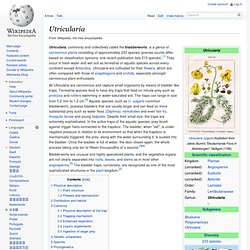
Utricularia are cultivated for their flowers, which are often compared with those of snapdragons and orchids, especially amongst carnivorous plant enthusiasts. All Utricularia are carnivorous and capture small organisms by means of bladder-like traps. Terrestrial species tend to have tiny traps that feed on minute prey such as protozoa and rotifers swimming in water-saturated soil. Physical description[edit] The tip of one stolon from a U.K. instance of U. vulgaris, showing stolon, branching leaf-shoots and transparent bladder traps. Nepenthes Around the House. Heliamphora. The genus Heliamphora (/hɛliˈæmfərə/ or /hiːliˈæmfərə/; Greek: helos "marsh" and amphoreus "amphora") contains 23 species of pitcher plants endemic to South America.[1] The species are collectively known as sun pitchers, based on the mistaken notion that the heli of Heliamphora is from the Greek helios, meaning "sun".
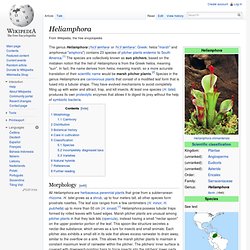
In fact, the name derives from helos, meaning marsh, so a more accurate translation of their scientific name would be marsh pitcher plants.[2] Species in the genus Heliamphora are carnivorous plants that consist of a modified leaf form that is fused into a tubular shape. They have evolved mechanisms to avoid completely filling up with water and attract, trap, and kill insects.
At least one species (H. tatei) produces its own proteolytic enzymes that allows it to digest its prey without the help of symbiotic bacteria. Morphology[edit] Carnivory[edit] Distribution[edit] Botanical history[edit] Genlisea. Genlisea /dʒɛnlɨˈsiːə/ is a genus of carnivorous plants also known as corkscrew plants.
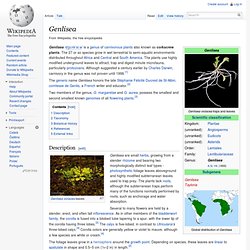
The 27 or so species grow in wet terrestrial to semi-aquatic environments distributed throughout Africa and Central and South America. The plants use highly modified underground leaves to attract, trap and digest minute microfauna, particularly protozoans. Although suggested a century earlier by Charles Darwin, carnivory in the genus was not proven until 1998.[1] Drosophyllum. Cephalotus.
Cephalotus (/ˌsɛfəˈloʊtəs/ or /ˌkɛfəˈloʊtəs/; Greek: κεφαλή "head", and οὔς/ὠτός "ear", to describe the head of the anthers)[2] is a genus which contains one species, Cephalotus follicularis, a small carnivorous pitcher plant.
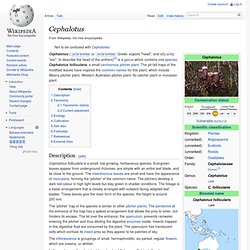
The pit-fall traps of the modified leaves have inspired the common names for this plant, which include Albany pitcher plant, Western Australian pitcher plant, fly-catcher plant or mocassin plant. Description[edit] The inflorescence is groupings of small, hermaphroditic, six-parted, regular flowers, which are creamy, or whitish. In the cooler months of winter (down to about 5 degrees Celsius), they have a natural dormancy period of about 3–4 months, triggered by the temperature drop and reduced light levels. Taxonomy[edit] Taxonomic history[edit] "Remaind on board. Brown initially gave this species the manuscript name "'Cantharifera paludosa' KG III Sound",[4] but this name was not published, and it would not be Brown who published the first description.
Byblis (plant) International Carnivorous Plant Society. Aldrovanda is a free-floating and rootless aquatic plant.
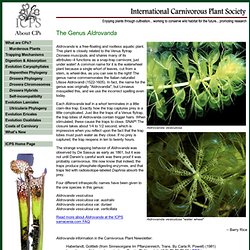
This plant is closely related to the Venus flytrap Dionaea muscipula, and shares many of its attributes--it functions as a snap-trap carnivore, just under water! A common name for it is the waterwheel plant because a single whorl of leaves, cut from a stem, is wheel-like, as you can see to the right! The genus name commemorates the Italian naturalist Ulisse Aldrovandi (1522-1605).
In fact, the name for the genus was originally "Aldrovandia", but Linnaeus misspelled this, and we use the incorrect spelling even today. Each Aldrovanda leaf in a whorl terminates in a little clam-like trap. The strange snapping behavior of Aldrovanda was observed by De Sassus as early as 1861, but it was not until Darwin's careful work was there proof it was probably carnivorous.
Four different infraspecific names have been given to the one species in this genus: Read more about Aldrovanda at the ICPS sarracenia.com FAQ -- Barry Rice. Easy Carnivores - Home. Plants & Fungi: Dionaea muscipula (Venus flytrap) - Species profile from Kew. How the Venus flytrap works The workings of the trap mechanism in Dionaea are complex and depend on changes in the osmotic potential of the cells in the hinge.

The traps close when one or other of the trigger hairs is touched more than once in quick succession; if nothing is caught, traps reopen after about a day. Once an insect is trapped, flaps close tighter to squash it, and enzymes are secreted to digest the prey. Pinguicula. Pinguicula, commonly known as the butterworts, is a genus of carnivorous plants that use sticky, glandular leaves to lure, trap, and digest insects in order to supplement the poor mineral nutrition they obtain from the environments.
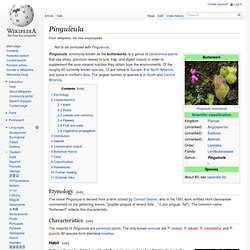
Of the roughly 80 currently known species, 12 are native to Europe, 9 to North America, and some in northern Asia. International Carnivorous Plant Society. The name Sarracenia honors Michel Sarrazin, an early 18th century Quebec botanist and surgeon.
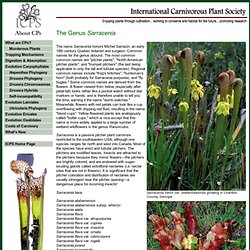
Common names for the genus abound. The most common common names are "pitcher plants", "North American pitcher plants", and "trumpet pitchers" (the last being applicable to only the tall and tubular species). Regional common names include "frog's britches", "huntsman's horn" (both probably for Sarracenia purpurea), and "fly bugles.
" Some common names are derived from the flowers. A flower viewed from below (especially after petal-fall) looks rather like a pocket watch without dial markers or hands, and is therefore unable to tell you the time, earning it the name "dumb watches. " Sarracenia is a passive pitcher plant carnivore restricted to the southeastern USA, although one species ranges far north and west into Canada.
Sarracenia taxa: Read more about Sarracenia at the ICPS sarracenia.com FAQ. -- Barry Rice. Germinating and Growing Sundews from seed and putting Drosera seeds through Cold Stratification. Germinating and Growing Sundews From Seed Growing sundews from seed is a somwhat slow process, but it can be very rewarding.

The easier tropical and subtropical Drosera can take anywhere from 1-6+ weeks to germinate, depending on the species and the viability of the seed. For more difficult sundews (such as tuberous Drosera), it may take more than 3 years for the seed to germinate. Sundews can reach maturity much faster than most other carnivorous plants as long as they are fed. Many Drosera species can grow to maturity in only one year or less. To learn about cold stratification, click here to be directed to the article belowTo learn how to speed up the growth of your seedlings significantly, click hereSee the Table of Contents at the right of this page for further assistance.